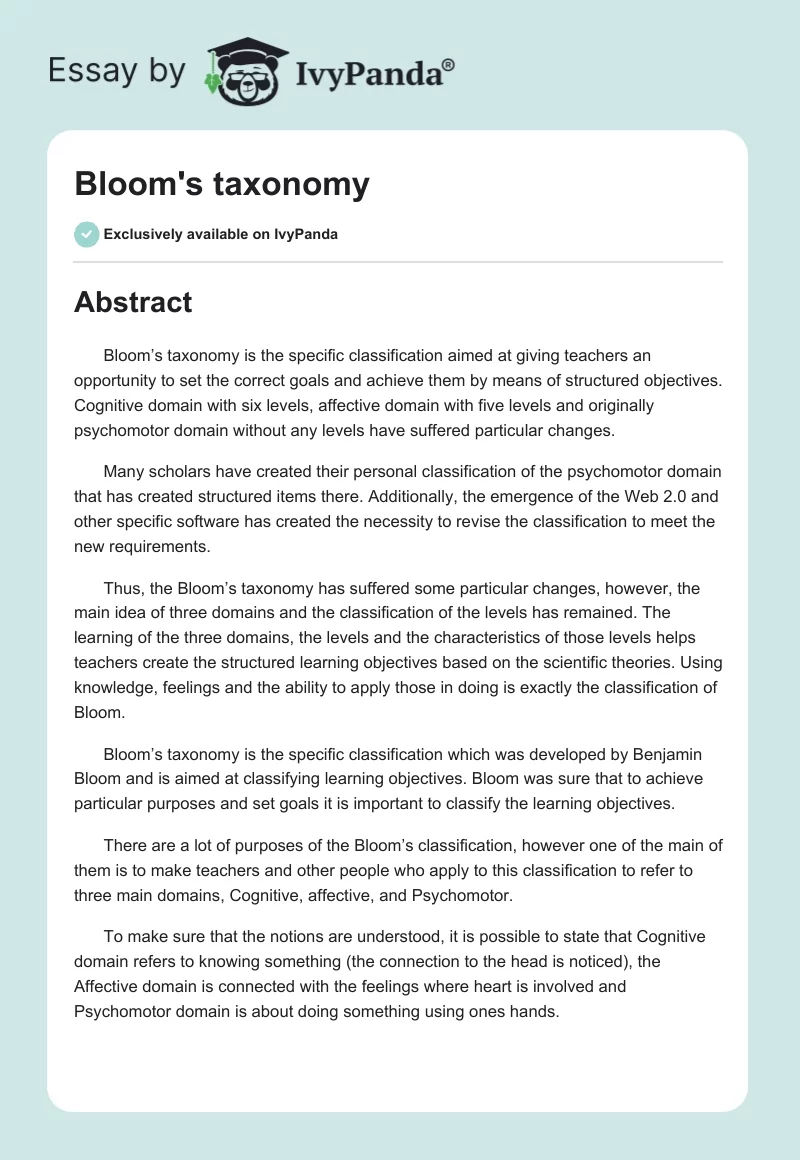Abstract
Bloom’s taxonomy is the specific classification aimed at giving teachers an opportunity to set the correct goals and achieve them by means of structured objectives. Cognitive domain with six levels, affective domain with five levels and originally psychomotor domain without any levels have suffered particular changes.
Many scholars have created their personal classification of the psychomotor domain that has created structured items there. Additionally, the emergence of the Web 2.0 and other specific software has created the necessity to revise the classification to meet the new requirements.
Thus, the Bloom’s taxonomy has suffered some particular changes, however, the main idea of three domains and the classification of the levels has remained. The learning of the three domains, the levels and the characteristics of those levels helps teachers create the structured learning objectives based on the scientific theories. Using knowledge, feelings and the ability to apply those in doing is exactly the classification of Bloom.
Bloom’s taxonomy is the specific classification which was developed by Benjamin Bloom and is aimed at classifying learning objectives. Bloom was sure that to achieve particular purposes and set goals it is important to classify the learning objectives.
There are a lot of purposes of the Bloom’s classification, however one of the main of them is to make teachers and other people who apply to this classification to refer to three main domains, Cognitive, affective, and Psychomotor.
To make sure that the notions are understood, it is possible to state that Cognitive domain refers to knowing something (the connection to the head is noticed), the Affective domain is connected with the feelings where heart is involved and Psychomotor domain is about doing something using ones hands.
Thus, each of these domains has some particular levels which are to be described in this article. Bloom’s taxonomy is the perfect tool which may help people navigate through the myriad items and may be helpful in making choices based on experience. Therefore, applying to the Bloom’s taxonomy, many people are guaranteed to be offered particular purposes to be achieved by means of applying to the necessary domains.
As it has already been mentioned, there are three main domains which have specific levels. Cognitive domain is connected with human head and should be associated with knowledge, thinking, and comprehension. At the lowest level of this domain is knowledge which should be applied for exhibiting the knowledge learnt before.
This is usually the basic knowledge which is used for further considerations. The understanding of those knowledge and other facts and ideas is usually conducted by means of the comprehension level of cognitive domain. Three main idea of this level is to translate, to interpret and to understand. Application of that knowledge and its understanding is the next level.
The analysis of the elements, relationships and organizational principles is can be applied to the next level of cognitive domain of Bloom’s taxonomy. The synthesis of the analyzed information is the fifth level of the classification and the final one is the evaluation of the data on the basis of the previous five levels of skills (Krathwohl, & Bloom, 2002).
The emotional reaction of people on some particular facts and events as well as human attitude, emotion and feelings are classified in the affective domain of Blooms taxonomy. This domain contains five levels. The lowest level is the receiving which is characterized by the passive attention of people to the situation, knowledge or event. Being a passive item, it is important to remember that no particular learning may occur without this level.
The next level is characterized by the responding to the perceived information and students’ interest in it. Further there is the valuing of the objects, information, or situation. Organizing and Characterizing are the final levels of Bloom’s taxonomy. It is important to understand that all the levels of the affective domain are important (Savickienė, 2010). Having not much in common with learning, people cannot achieve any results if affective domain is not followed precisely.
Psychomotor domain is characterized by human ability to use and physically manipulate students’ hands. Even though Bloom has never created the levels to this domain, some scholars thought about their own levels of taxonomy. Perception, set, guided response, mechanism, complex overt response, adaptation, and origination are the seven levels of the psychomotor domain which may be considered (Lightle, 2011).
Therefore, returning to the cognitive and affective domains, it is important to understand that the lowest levels are as important as the highest ones. The classification is based on the application of different skills and the basis for them. Thus, not much is necessary for getting the knowledge, however, students are to come through a number of stages to make an evaluation.
The same is with the affective domain. Bloom/s taxonomy has been revised as the creation of the innovative technologies and Web 2.0 some particular changes were necessary. However, the main idea of the taxonomy has remained the same.
Reference List
Krathwohl, D. R., & Bloom, B. S. (2002). Taxonomy of educational objectives: the classification of educational goals. London: Longman.
Lightle, K. (2011, May). More than just the technology. Science Scope, 34(9), 6-9.
Savickienė, I. (2010). Conception of learning outcomes in the bloom’s taxonomy affective domain. Quality of Higher Education, 7, 37-57.


